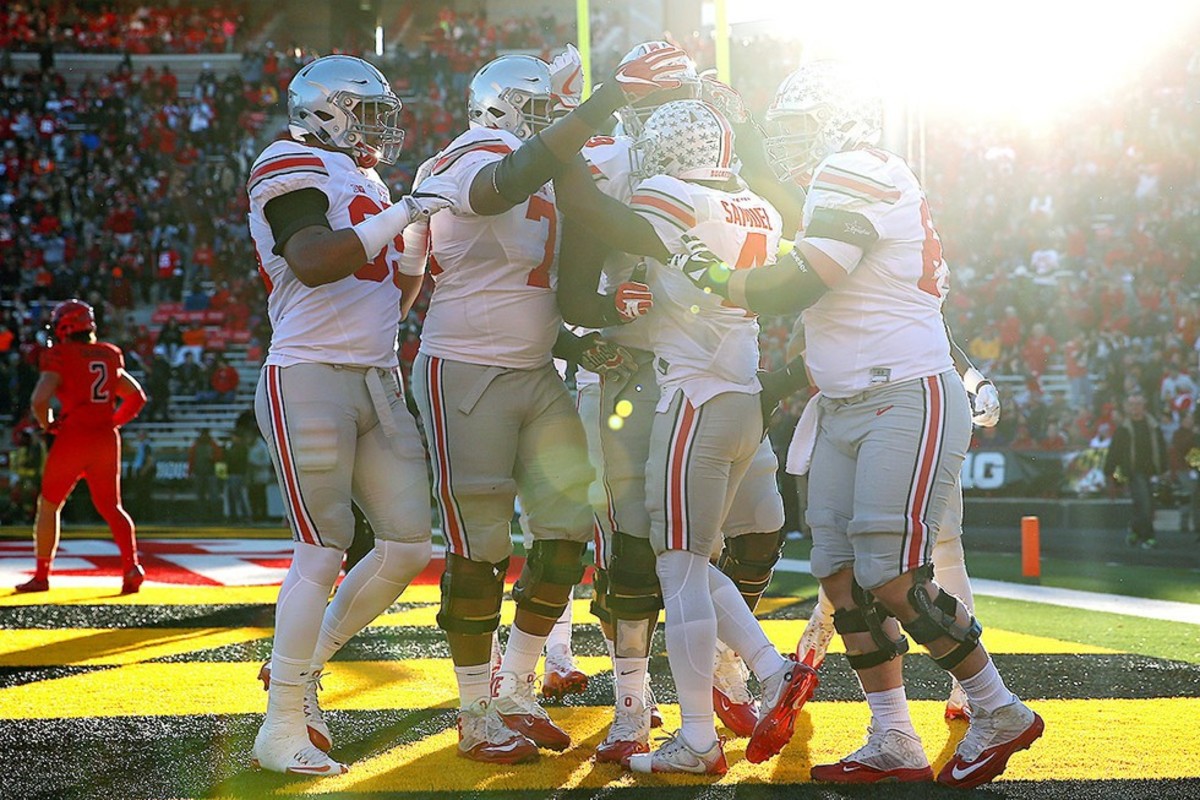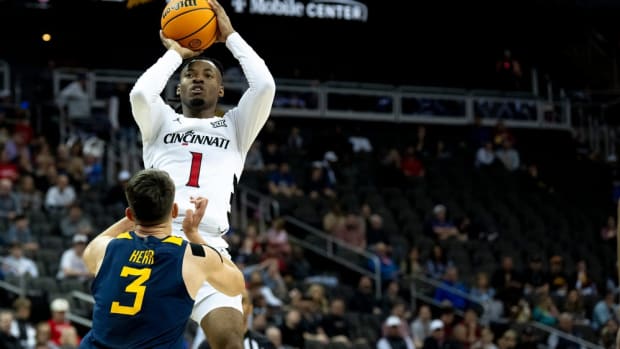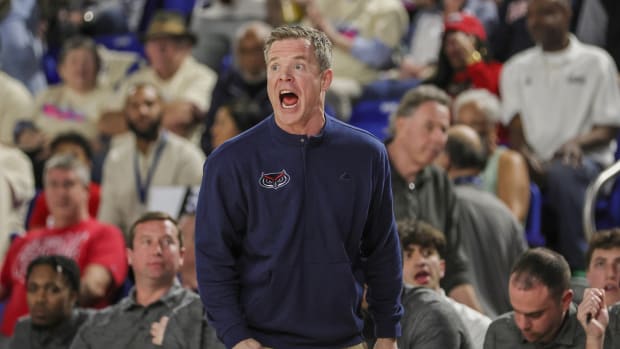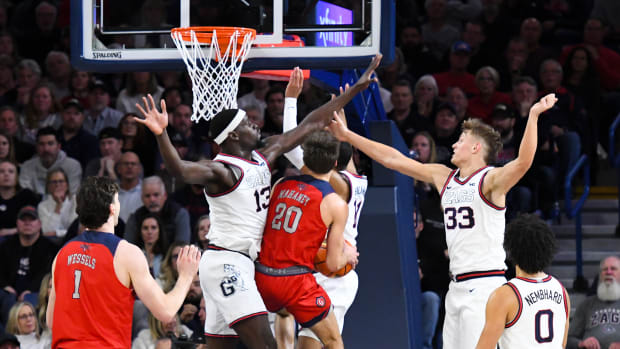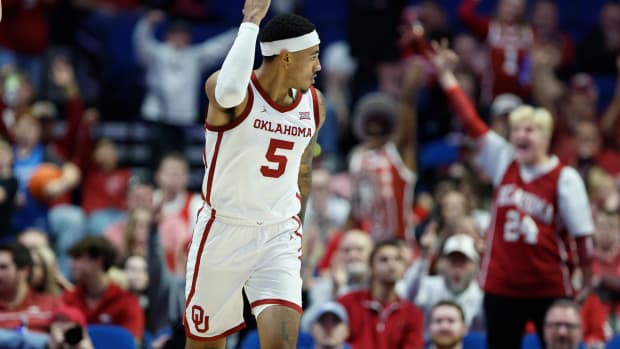The Drummer, the Cop and the Med Student: How Ohio State reloaded from draft losses to stay a playoff contender
\n\n
COLUMBUS, Ohio – A poster propped up on a tripod greets every Ohio State football player daily when they enter the Woody Hayes Athletic Complex. It's an action shot of tailback Ezekiel Elliott streaking down the field with the football tucked firmly in his right arm. Aside the picture is a quote from Elliott in an oversized font: "When you're used to competing at a high level every week, you don't have a choice to grow up fast. I mean, you grow up fast or you're left behind."
The sign doubles as both a plea and a warning for the 2016 Buckeyes, which debuted 16 new starters this fall after 12 Buckeyes got drafted in the first four rounds of last spring's NFL draft.
When No. 2 Ohio State plays No. 3 Michigan on Saturday, the Buckeyes' overhauled roster will be on display. In many ways, Ohio State's resuscitation to a College Football Playoff contender this season highlights how it overcame that sudden and massive talent drain. Of the 96 college football players who declared early for the NFL draft last season, nine came from Ohio State. Early-entry numbers around college football have tripled since 2000 and doubled since 2009, leaving high-end schools like Ohio State in a constant state of regeneration.
That's forced the Buckeyes to streamline the development of young talent, making this Ohio State team's success largely a testament to Urban Meyer's refined system. The development of players like redshirt sophomore safety Malik Hooker, redshirt freshman tailback Mike Weber and true freshman guard Michael Jordan proves there's an intricate process behind Elliott's Darwinian warning.
Those players' emergence from anonymity to stardom highlights a refined system of physical, mental and social development that's evolved throughout Meyer's career. "We don't treat guys as numbers," Meyer says. "There's no cookie cutter recipe for how to handle a player. Every player's got their own journey, their own story. It's our obligation, not their obligation, to get it. And that's why I think we're a little different."
A doctor, a cop and a drummer in a rock band walk into Ohio State's football facility sounds like the lead-in to a corny joke. But it's actually the best place to start explaining how these young Buckeyes got so good so fast.
Gerald Herbert/AP
The Drummer
In the Ohio State running back room this summer, none of the full-time tailbacks had ever taken a college carry. The projected starter, Mike Weber, spent his first year in the program battling weight issues, pondering a transfer and nearly getting into a fistfight with star quarterback J.T. Barrett.
Running backs coach Tony Alford asked Weber if he had any advice for true freshman tailbacks Demario McCall and Antonio Williams. "Do it their way," Weber said of the coaches. "Don't do it your way. Your way won't work." At that moment, Alford knew Weber's development had come full circle.
The four-star recruit from Detroit arrived at Ohio State weighing nearly 230 pounds, much thanks to a 13% body-fat percentage. He carried a malaise of ambivalence, rarely engaging with teammates and coaches. Like many high school stars, he rarely needed to push himself to dominate the competition.
Weber trusted few people in the Ohio State program after the assistant coach who'd recruited him, Stan Drayton, jumped to the NFL soon after signing day. The only coach he immediately connected with was longtime strength coach Mickey Marotti, Meyer's indispensible confidant. "I trust Mickey more than I trust myself when it comes to players," Meyer says. "He knows more."
ROSENBERG: From Ohio State-Michigan rivalry, a story of friendship
Marotti nicknamed Weber "Fat Mike" and noticed qualities that doubled as evil cousins of the Seven Dwarves. "He was lippy, mopey and lazy," Marotti says. "All those bad words."
In his 27 th season as a full-time strength coach, Marotti has seen the profession evolve from he and an assistant handling 20 sports and 450 athletes at Cincinnati to a 10-person operation at Ohio State that oversees just football. There are staffers in charge of pee tests for hydration and omega waves to monitor stress, sleep and recovery.
These days, Marotti makes $516,000 a year, and his title is Assistant Athletic Director for Football Sport Performance. But the essence of his job is still rooted back at Cincinnati, where he learned about connecting and motivating players like Fat Mike. Instead of becoming the rock band drummer like he wanted to, Marotti keeps a beat on every Buckeyes player. "He was probably the only person I liked when I got here," Weber says of Marotti. "He kept it real. He was always on you because he sees the potential in you and never lets you slack."
Jamie Sabau/Getty Images
Weber tore his meniscus last August, an injury that sidelined him during fall camp and ultimately led to his redshirt. As Elliott blew up to become the No. 4 pick in the NFL draft, Weber wanted out. "I told coach I wanted to transfer," he says. "I was super close. I had talks with coach Meyer, coach Alford."
Meyer talked Weber back on board, and he and Marotti agreed they needed to get him to the off-season. That's where the development really began to unfold. Marotti paired Weber in a workout group with quarterback J.T. Barrett and a crew of ornery veterans. "I told him," Marotti says, "'We're only going to be as good as Fat Mike is going to be.'"
The turning point came in February. Weber leaned over exhausted in the weight room after enduring a punishment workout. Barrett saw Weber bent over "on the verge of giving up" and confronted him. Weber stepped into him, and the two nearly got in a fistfight. "I attacked him in the moment," Barrett says. And the quarterback delivered a clear message: "This is so much bigger than you. You want to be our running back?"
At that moment, Weber began to realize his way wasn't working. Soon, Marotti's grand plan was. Weber saw the traits of real leadership, like offensive lineman Pat Elflein showing up in a sling after surgery to encourage Weber, even if he couldn't work out himself. As Fat Mike trimmed down, he started to grow up. Weber lost 15 pounds and dropped to 8% body fat. He became Ohio State's featured back in the spring, and this fall he joined Robert Smith (1990) and Maurice Clarett (2002) as the only freshman Buckeyes to eclipse the 1,000-yard mark. "He's come a long way, man," Marotti says.
Khris Hale/Icon Sportswire via Getty Images
The Cop
Malik Hooker admits with a halogen smile that he's a "mama's boy." When he arrived at Ohio State in 2014, the combination of being buried on the depth chart and away from his home in New Castle, Pa., left him wanting to transfer. Hooker's crossroads led him to a converted closet in the middle of Ohio State's facility, where he got advice from a former policeman named Ryan Stamper.
To almost everyone in the Ohio State program, the 29-year old Stamper is known exclusively as "Stamp," and fittingly his imprint is on every aspect of the program. Hooker's career arc from struggling freshman to breakout star as a redshirt sophomore is indicative of the fact that thriving in college football has just as much to do with off-field adjustment.
Enter Stamper, who meets players as recruits, guides them to class as freshmen and is on call constantly as a big brother. Need the next day's schedule? Text Stamp at midnight. Having trouble in class? Ask Stamp for advice. Butting heads with your position coach? Go to Stamp to vent. Need an internship? Stamp knows all the connections in town.
There's no part of the Ohio State program Stamper doesn't touch. He's a liaison for the police, bar managers, academic tutors, concerned parents and Meyer. On a typical day, he can talk with athletic director Gene Smith and campus housing officials and arrange for speakers like Roger Goodell and Jamie Dimon to address the Buckeyes players. "He does it all, underlined and bolded," Meyer says.
VAILLIENCOURT: Big Ten in prime position to get two playoff teams
Stamper's sparse office lacks space and aesthetics, but the location is ideal. It's wedged at an intersection between the offensive staff room and team meeting room and about a first-down from the players' and coaches' locker room. Nothing in the Ohio State football orbit gets past Stamper because everyone is constantly passing him.
Hooker found himself in Stamper's office during his first few months on campus. "He just kept telling me everything would be all right," Hooker says. "He'd seen everything play out multiple times before."
Stamper could relate to Hooker's struggles because he endured them. When Meyer recruited him to Florida in 2005, Stamper redshirted and recalls being embarrassed to go home to Jacksonville and having to explain why he wasn't playing. Stamper ended up as a starter, captain and second-team All-SEC player despite not being a genetic freak like many of his teammates. He credits his career to confidence, which was built through training with Marotti—then Florida's strength coach, who Stamper says is the key to Ohio State's development—and mastering the defense.
Donald Miralle/Getty Images
A decade later, Stamper helps instill confidence. He realizes how much harder things are in 2016, as social media and recruiting hype has increased pressure. "At a program like this, USC, Texas or Georgia, if you don't have someone like me that can cut through all the noise and talk to the players and keep it real," Stamper says, "I don't know how they're surviving."
Stamper majored in criminology and spent a year-and-a-half as a policeman in Titusville, Fla., before Meyer called to add him to the staff at Ohio State five years ago. He planned on being a graduate assistant and eventually a coach but started out in this position and decided he didn't want to leave. (Stamper makes $80,250). "I felt it was my calling," he says. "This role done right will help guys and impact lives more than any coach would."
Stamper noticed Hooker's struggles early on and did little things to encourage him. He nicknamed him "Malik The Freak," a nod to his supreme athleticism. When Hooker made a big play in practice, Stamper went out of his way to celebrate him. Stamper coached up Hooker's demeanor after he noticed Hooker would suck his teeth and walk around the facility looking sullen.
For Hooker, the turning point came with building his body and his confidence. Just like Stamper back at Florida. His improved physique and footwork technique eventually led to making plays in practice. After Tyvis Powell left early for the NFL, Hooker has managed to become an upgrade at safety for the Buckeyes. He leads the team with five interceptions for a secondary that's snagged 17. "He's got the potential to be as good as anyone I've ever coached," Ohio State co-defensive coordinator Greg Schiano says, "and I've coached Ed Reed."
In his first season of significant playing time, Hooker is already receiving early projections in NFL mock drafts as a first-round pick. For Stamper, it's another example of why he followed his calling to coach players off the field instead of on it. "Honestly," Hooker says of Stamper, "he's whatever you need him to be."
Jay LaPrete/AP
The Med Student
When Michael Jordan started as a true freshman against Bowling Green to open the 2016 season, it marked a generational achievement for an Ohio State offensive lineman. The last Buckeyes true freshman to start on the offensive line was Orlando Pace in 1994. He went on to be an All-America and No. 1 NFL draft pick and got inducted into the NFL Hall of Fame earlier this year.
While that's the loftiest of comparable career trajectories, high-end recruits like Jordan capable of an immediate impact have become a necessity for the Buckeyes. Since Meyer arrived in December 2011, Ohio State has recruited the best class in the Big Ten and a top 10 class every year, according to Scout.com's rankings.
The person responsible for organizing, monitoring and building relationships to keep up that recruiting run is a 35-year-old who ditched medical school to intern in Florida's recruiting office.
Mark Pantoni never played a down of football in his life, but his ability to diagnose the right traits in recruits has led to him being widely acknowledged as the college football's top Director of Player Personnel.
SHOP: Get Ohio State-Michigan rivalry gear and more
Pantoni attended Florida, following the football team so closely that he would road-trip to a majority of the SEC away games. He and his now-wife Kristin even once slept in a mini-van in Baton Rouge to attend a game at LSU. Pantoni earned a 3.8 grade-point average as an undergrad at Florida and earned a prestigious internship with noted surgeon Dr. James Andrews's medical research group. Pantoni wanted to be an orthopedic surgeon but couldn't shake the feeling he got when he'd go to Florida's spring practice sessions. "I'd sit in the grass, usually by myself, and think to myself: Someday I want to be part of this."
Pantoni graduated from Florida in 2004, took a year off to study for the MCATs and ended up back at Florida in graduate school in 2006. A job helping out the track program led to a volunteer opportunity helping in the Gators' football recruiting office. Pantoni made himself invaluable, showing a knack for giving recruits' families campus tours and a deft touch with technology.
By 2007, Pantoni made $25,000 a year, and his tasks were upgraded to things like fetching recruits at the airport. (His first pick-up? A shy tight end from Connecticut named Aaron Hernandez.) His first big test came when Meyer asked him to look after his father, Bud Meyer, for a game weekend. "That was the old, can I trust you?" Pantoni recalls with a laugh.
The trust kept building, and over time Pantoni learned football well enough that he impressed Meyer with his ability to streamline the best recruits for the Gators coaches to watch. By the time Meyer got the Ohio State job, Pantoni was one of his first phone calls and hires. From an unpaid intern grunt, he now makes $140,000 a year and serves as the face of the program's recruiting publically. The results have been obvious, as five Buckeyes were among the top 20 players selected in the 2016 NFL draft.
Tino Bovenzi
"He's very important to what we do because he has the time to do it," Meyer says. "He has the time to prioritize our work. Ultimately, it's our coaches' decision on evaluating and who we take." Diligence separates the Ohio State recruiting staff, as they pride themselves on watching every snap of each of their recruits' high school seasons. They typically pull the 15 best plays and five worst from all that film to help the Buckeyes coaches make informed decisions.
For Pantoni, a key is making sure the recruits can thrive once they arrive in Columbus. He stays connected with recruits through texts and social media, monitors their posts and organizes how Meyer and the assistant coaches utilize visits. The process is so refined that the Buckeye staff has already delineated 2017 recruiting commitments and targets into three academic categories: blue (high risk), red (average) and gold (no risk).
Jordan came to Ohio State as a gold recruit, enrolled early and has played as well as any true freshman lineman in the country. His presence has solidified an offensive line lacking depth and considered one of the program's biggest question marks heading into the season. Considering his talent, physical gifts and mental make-up, no one will be surprised if he follows the three-and-done cycle that's become commonplace for top recruits.
On a recent November evening, Jordan marveled at how quickly the past year has flown by. He's cut his body fat by 9%, adjusted to college and won a starting job for a playoff contender. Each day as he's passed the sign with Elliott's warning about growing up or getting left behind, he's forged ahead. "I agree with that statement," he said with a chuckle, "100%."
